Question
The term used for transfer of pollen grains from anthers of one plant to stigma of a different plant which, during pollination, brings genetically different types of pollen grains to stigma is [NEET 2021]
(a) xenogamy
(b) geitonogamy
(c) chasmogamy
(d) cleistogamy
Answer/Explanation
Ans. (a)
Xenogamy is a cross pollination in which pollen grains are transferred from anther of one flower to the stigma of another flower in order to get fertilised. This is the only type of cross pollination which during pollination brings genetically different types of pollen grains to the stigma, e.g. Sunflower.
Other options can be explained as:
Geitonogamy is a type of self-pollination in which pollens are transferred from the anther of one flower to the stigma of another flower of the same plant, e.g. Corn.
Chasmogamy is the condition in which bisexual flowers have exposed anthers and stigma. Both self-pollination and cross pollination can occur in these flowers, e.g. Catharanthus.
Cleistogamy occurs in flowers that do not open, their anther and stigma lie close to each other thus, production of seeds is a result of autogamy, e.g. Arachis hypogaea.
Question
Diadelphous stamens are found in [NEET 2021]
(a) China rose
(b) Citrus
(c) Pea
(d) China rose and Citrus
Answer/Explanation
Ans. (c)
Diadelphous condition is a condition of arrangement of filaments and stamen in a flower, e.g. Pea. In this condition, filaments of nine different stamens are connected into one unit and the tenth posterior stamen remains out of the bundle as a stand part.
The androecium of pea flower is diadelphous because the filaments of the anther are united in two bundles. In the case of pea, out of ten, nine stamens form a staminal tube while one is free. Thus, the correct answer is ‘Pea’ which exhibit diadelphous condition.
China rose of Malvaceae family possess numerous stamens. The filaments of stamens are united in one group thus forming a staminal tube around the style. Such stamens are called monadelphous. The polyadelphous stamen is seen in Citrus, these have many small bunches of the fused stamen.
Question
A typical angiosperm embryo sac at maturity is [NEET 2021]
(a) 8-nucleate and 7-celled
(b) 7-nucleate and 8-celled
(c) 7-nucleate and 7-celled
(d) 8-nucleate and 8-celled
Answer/Explanation
Ans. (a)
In dicotyledons, at the time of fertilisation, the female gametophyte develops from a single megaspore.
The megaspore will undergo three successive mitotic divisions to form eight nucleated embryo sac. Two nuclei generated in the first mitotic division in the megaspore will move to opposite poles. These nuclei divided and redivide at their ends to form eight nucleated stage. Thus, each end have four nuclei, out of which at micropylar end towards, three nuclei differentiate into two synergids and one egg cell, while at the chalazal end, three nuclei differentiate as antipodal cells.
The remaining two cells, one at micropylar end and other at chalazal end migrate the center and fuse.
Hence, a typical angiosperm embryo sac at maturity is 7 celled and 8 nucleated structure.
Question
In some members of which of the following pairs of families, pollen grains retain their viability for months after release? [NEET 2021]
(a) Poaceae; Rosaceae
(b) Poaceae: Leguminosae
(c) Poaceae: Solanaceae
(d) Rosaceae: Leguminosae
Answer/Explanation
Ans. (d)
In some members of Rosaceae, Leguminosae and Solanaceae pollen grains maintain viability for a month due to sporopollenin.
The outer wall or exine of pollen grains contains sporopollenin. It is one of the most resistant organic compounds known. It protects pollen grains from external factors such as temperature, acid, alkali, etc. because of sporopollenin, pollen grains are preserved as fossils.
Question
Which of the following is incorrect for wind pollinated plants? [NEET (Oct.) 2020]
(a) Well exposed stamens and stigma
(b) Many ovules in each ovary
(c) Flowers are small and not brightly coloured
(d) Pollen grains are light and non-sticky
Answer/Explanation
Ans. (b)
Option (b) is incorrect because wind pollinated plants have single ovule in each ovary. In case of wind pollination or anemophily, many pollens are produced because anemophily is highly wasteful and non-directional process.
These pollens are also light-weighed, small, dusty and dry. To catch the wind-borne pollens, stigma is exposed and hairy. Flowers are small and inconspicuous, colourless and nectarless.
Question
In water hyacinth and water lily, pollination takes place by [NEET (Sep.) 2020]
(a) water currents only
(b) wind and water
(c) insects and water
(d) insects or wind
Answer/Explanation
Ans. (d)
In water hyacinth and water lily, the flowers emerge above the level af water and are thus pollinated by insects or wind. Water lily and water hyacinth are in the water but their stem part which is above the thalamus is not in water. The pollen grains are in the upper part of thalamus so pollination cannot be done by water. That is why it done by insects or wind.
Question
The plant part which consists of two generations, one within the other [NEET (Sep.) 2020]
I. Pollen grains inside the anther.
II. Germinated pollen grain with two male gametes.
II. Seed inside the fruit.
V. Embryo sac inside the ovule.
(a) I, II and III
(b) III and IV
(c) 1 and IV
(d) Only 1
Answer/Explanation
Ans. (c)
The plant part which consists of two generations one within the other are pollen grains inside the anther and embryo sac inside the ovule.
This can be explained as : In an ovule or megasporangia $(2 n)$ there occurs an embryo sac or female gametophyte which consists of an egg cell(n). This egg cell or female gamete is the part of next generation which form zygote after syngamy. Likewise an anther $(2 n)$ is a male reproductive structure of a plant. As the anther mature and dehyrate, it form pollen grains via microsporogenesis. These pollen grains represents the male gametophyte comprising of male gametes (n). So in this way there occurs two generations one with the other.
Question
What type of pollination takes place in Vallisneria? [NEET (Odisha) 2019]
(a) Pollination occurs in submerged condition by water
(b) Flowers emerge above surface of water and pollination occurs by insects
(c) Flowers emerge above water surface and pollen is carried by wind
(d) Male flowers are carried by water currents to female flowers at the surface of water
Answer/Explanation
Ans. (d)
Vallisneria is a water pollinated plant. In Vollisneria, the female flowers reach the surface of water by the long stalk and the male flowers or pollen grains are released on to the surface of water. They are carried passively by water currents to female flowers at surface of water.
Question
In which of the following, both autogamy and geitonogamy are prevented? [NEET (Odisha) 2019]
(a) Wheat
(b) Papaya
(c) Castor
(d) Maize
Answer/Explanation
Ans. (b)
Autogamy and geitonogamy both are prevented in papaya plant. In papaya, male and female flowers are present on different plants that is each plant is either male or female (dioecy).
Question
Pollen grains can be stored for several years in liquid nitrogen having temperature of [NEET 2018]
(a) $-196^{\circ} \mathrm{C}$
(b) $-80^{\circ} \mathrm{C}$
(c) $-120^{\circ} \mathrm{C}$
(d) $-160^{\circ} \mathrm{C}$
Answer/Explanation
Ans. (a)
Pollen grains can be stored for several years in liquid nitrogen having a temperature of $-196^{\circ} \mathrm{C}$. Pollen grains can be later used in plant breeding programmes.
Question
Which of the following has proved helpful in preserving pollen as fossils? [NEET 2018]
(a) Oil content
(b) Cellulosic intine
(c) Pollenkitt
(d) Sporopollenin
Answer/Explanation
Ans. (d)
Sporopollenin has proved helpful in preserving pollen as fossils. The covering of pollen grain, sporoderm is consist of two layers, viz., exine and intine. Exine is made of a highly resistant fatty substance called sporpollenin.
It could not be degraded by any enzyme. It is not affected by high temperature, strong acid or strong alkali. Thus, it keeps the pollen grains well-preserved as fossils. Pollenkitt is a yellowish, viscous, sticky and oily layer that covers exine of some insect pollinated pollen grains. Intine of pollen grains is made up of pectin and cellulose.
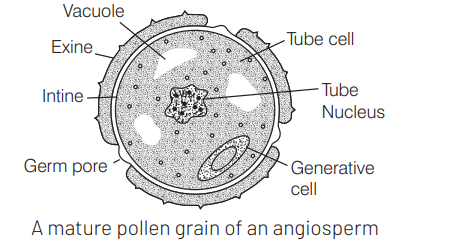
Question
Winged pollen grains are present in [NEET 2018]
(a) mango
(b) Cycas
(c) mustard
(d) Pinus
Answer/Explanation
Ans. (d)
Winged pollen grains are present in Pinus. These wings are spirally arranged microsporophylls that arise from the lateral side and help in pollination. The sperms (pollen grains) of Cycas are
top-shaped. The pollen grains of mango are spheroidal, while that of mustard are prolate to subspheroidal.
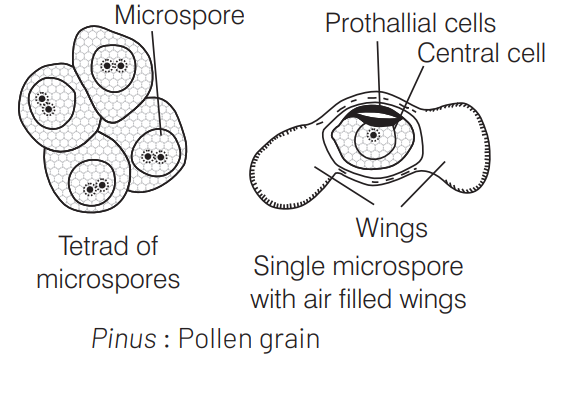
Concept Enhancer In Pinus, the pollination is anemophilus. Pollen remains suspended in the air for a long time due to wings. It appears as yellow dust. This is popularly called as phenomenon of ‘sulphur shower’.
Question
Attractants and rewards are required for [NEET 2017]
(a) anemophily
(b) entomophily
(c) hydrophily
(d) cleistogamy
Answer/Explanation
Ans. (b)
Attractant and rewards are required for entomophily (insect pollination). Flowers produce specific odour and nectar to attract the insect for effective pollination. Entomophilous flowers are large with bright colours.
Question
A dioecious flowering plant prevents both [NEET 2017]
(a) autogamy and xenogamy
(b) autogamy and geitonogamy
(c) geitonogamy and xenogamy
(d) cleistogamy and xenogamy
Answer/Explanation
Ans. (b)
Dioecious flowering plants contain unisexual flower. In dioecious condition two types of unisexual flowers occur on different plants.
Hence, it does not favour autogamy and geitonogamy because autogamy takes place in bisexual flowers and geitonogamy takes place between different flower of the same plant.
Question
Functional megaspore in an angiosperm develops into [NEET 2017]
(a) ovule
(b) endosperm
(c) embryo sac
(d) embryo
Answer/Explanation
Ans. (c)
In angiosperms, functional megaspore develops into an embryo sac. The functional megaspore is the first cell of female gametophyte.
Question
Which one of the following statements is not true? [NEET 2016, Phase I]
(a) Exine of pollen grains is made up of sporopollenin
(b) Pollen grains of many species cause severe allergies
(c) Stored pollen in liquid nitrogen can be used in the crop breeding programmes
(d) Tapetum helps in the dehiscence of anther
Answer/Explanation
Ans. (d)
Tapetum is the inner layer of microsporangium (anther) which provides nourishment to developing pollen grain after meiotic cell division.
Question
Proximal end of the filament of stamen is attached to the [NEET 2016, Phase I]
(a) connective
(b) placenta
(c) thalamus or petal
(d) anther
Answer/Explanation
Ans. (c)
A typical stamen consist of anther and filament. The proximal end of filament is attached to thalamus or petal of the flower whereas distal end bears anther.
Question
Which of the following statements is not correct? [NEET 2016, Phase I]
(a) Insects that consume pollen or nectar without bringing about pollination are called pollen nectar robbers
(b) Pollen germination and pollen tube growth are regulated by chemical components of pollen interacting with those of the pistil
(c) Some reptiles have also been reported as pollinators in some plant species
(d) Pollen grains of many species can germinate on the stigma of a flower, but only one pollen tube of the same species grows into the style
Answer/Explanation
Ans. (d)
Pollen grains of different species are incompatible, so they fail to germinate. Only the pollen of the same species germinate and can form pollen tube which grows and finally dispatches male gamete to embryo sac.
Question
In majority of angiosperms [NEET 2016, Phase II]
(a) egg has a filiform apparatus
(b) there are numerous antipodal cells
(c) reduction division occurs in the megaspore mother cells
(d) a small central cell is present in the embryo sac
Answer/Explanation
Ans. (c)
In most of the angiosperms megaspore mother cell (2n) divides meiotically to produce 4 cells. Out of these 3 degenerate and one remains which forms functional megaspore. This divides mitotically and forms embryo sac which contains following structures.
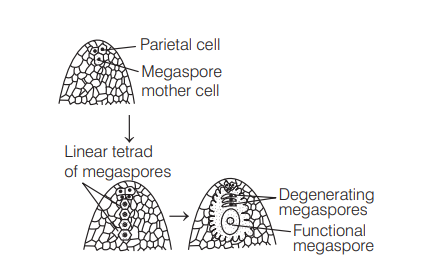
(i) One egg cell with 2 synergids forming an egg apparatus.
(ii) There are 3 antipodal cells.
(iii) There are two central cells which are seen as secondary nucleus (2n). Egg does not have filiform apparatus. It is the synergids which have special cellular thickenings at the micropylar tip which is called filiform apparatus. This guides pollen tube into the synergids.
Question
Pollination in water hyacinth and water lily is brought about by the agency of [NEET 2016, Phase II]
(a) water
(b) insects or wind
(c) birds
(d) bats
Answer/Explanation
Ans. (b)
Water hyacinth has single spike of 8-15 conspicuous attractive flowers which attract bees and other insects. These insects pollinate them. This plant is an aquatic weed. Water lily is also an aquatic plant with large conspicuous coloured flowers. Most of the species are bee pollinated except few species where wind pollination occurs. Insect pollinated flowers have coloured petals, big size and they offer fragrance and nectar to attract insects which bring about pollination in them.
Question
The ovule of an angiosperm is technically equivalent to [NEET 2016, Phase II]
(a) megasporangium
(b) megasporophyll
(c) megaspore mother cell
(d) megaspore
Answer/Explanation
Ans. (a)
Ovule of an Angiosperm is equivalent to megasporangium which consists of 2 synergids, 1 egg, 3 antipodal cells and a secondary nucleus. Megaspore mother cell $(2 n)$ gives rise to ovule. Megasporophylls are sterile structures on which ovules may be present.
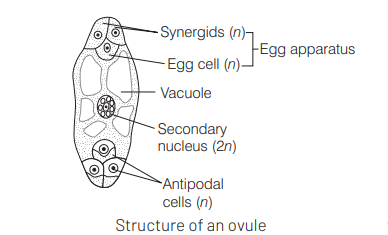
Question
Male gametophyte in angiosperms produces [CBSE AIPMT 2015]
(a) two sperms and a vegetative cell
(b) single sperm and a vegetative cell
(c) single sperm and two vegetative cells
(d) three sperms
Answer/Explanation
Ans. (a)
Pollen grain or male gametophyte in angiosperms contain one generative cell. The generative cell further divides mitotically to form two male gametes (sperms). So, a mature male gametophyte in angiosperms contains two sperms and one vegetative cell.
Question
Filiform apparatus is characteristic feature of [CBSE AIPMT 2015]
(a) generative cell
(b) nucellar embryo
(c) aleurone cell
(d) synergids
Answer/Explanation
Ans. (d)
Filiform apparatus are finger-like projections present at the micropylar end of synergids of embryo sac.
Question
In angiosperms, microsporogenesis and megasporogenesis [CBSE AIPMT 2015]
(a) occur in anther
(b) form gametes without further divisions
(c) involve meiosis
(d) occur in ovule
Answer/Explanation
Ans. (c)
Both event microsporogenesis and megasporogenesis involve the process of meiosis which results in the formation of haploid gametes from the microspore or megaspore mother cells.
Question
Geitonogamy involves [CBSE AIPMT 2014, 10, 94]
(a) fertilisation of a flower by the pollen from, another flower of the same plant
(b) fertilisation of a flower by the pollen from the same flower
(c) fertilisation of a flower by the pollen from a flower of another plant in the
(d) fertilisation of a flower by the pollen from a flower of another plant belonging to a distant population
Answer/Explanation
Ans. (a)
Geitonogamy is a type of self pollination. In other word geitonogamy is transfer of pollen grain from the anther of one flower to the stigma of another flower of either same or genetically similar plant.
Question
Pollen tablets are available in the market for [CBSE AIPMT 14]
(a) in vitro fertilisation
(b) breeding programmes
(c) supplementing food
(d) ex situ conservation
Answer/Explanation
Ans. (c)
Pollen grains are rich in nutrients. They are taken as tablets and syrups to improve health. Pollen consumption has been claimed to enhance the performance of athletes and race horses.
Question
Function of filiform apparatus is to [CBSE AIPMT 2014, 2008]
(a) recognise the suitable pollen at stigma
(b) stimulate division of generative cell
(c) produce nectar
(d) guide the entry of pollen tube
Answer/Explanation
Ans. (d)
Filiform apparatus of synergids secrete some chemotropically active substances, which direct the pollen tube towards micropyle of ovule.
Question
Megasporangium is equivalent to [NEET 2013]
(a) embryo sac
(b) fruit
(c) nucellus
(d) ovule
Answer/Explanation
Ans. (d)
Megasporangium is equivalent to an ovule. An ovule generally has a single embryo sac formed from a megaspore through reduction division. It is a small structure attached to the placenta by means of a stalk called funicle. Each has one or two protective envelopes called integuments. Nucellus is a mass of cells enclosed with in the integuments. ovule forms Megaspore Mother Cell (MMC) by meiosis which further forms megaspore. Megaspore nucleus forms embryo sac. Fruits develop from the ovary of flower, other floral parts degenerate and fall off.
Question
Which one of the following statement is correct? [NEET 2013]
(a) Hard outer layer of pollen is called intine
(b) Sporogenous tissue is haploid
(c) Endothecium produces the microspores
(d) Tapetum nourishes the developing pollen
Answer/Explanation
Ans. (d)
Tapetum is the innermost layer of microsporangium. It nourishes the pollen grains. The inner wall of pollen grain is called intine. Endothecium is the wall around the microsporangium, which provide protection and help in dehiscence of anther to release the pollen. Sporogenous tissue is diploid. It undergoes meiotic division to form microspore tetrads.
Question
Advantage of cleistogamy is [NEET 2013]
(a) higher genetic variability
(b) more vigorous offspring
(c) no dependence on pollinators
(d) vivipary
Answer/Explanation
Ans. (c)
In cleistogamous flowers, anthers and stigma lie close to each other. When anthers dehisces in the flower buds, pollen grains come in contact with the stigma to effect pollination. Thus, these flowers produce assured seed set even in the absence of pollinators.
Question
The higher genetic variability and more vigorous offsprings are produced due to variations obtained by sexual reproduction. Vivipary relates to the birth of young babies from mammals.
Both, autogamy and geitonogamy are prevented in [CBSE AIPMT 2012]
(a) papaya
(b) cucumber
(c) castor
(d) maize
Answer/Explanation
Ans. (a)
Autogamy involves pollination within the same flower, while geitonogamy involves transfer of pollen grains from the anther of one flower to the stigma of another flower of the same plant.
Both the processes are prevented in papaya because it is a dioecious plant (i.e. male and female sex organs are born on separate plants) and it always needs cross-pollination.
Question
An organic substance that can withstand environmental extremes and cannot be degraded by any enzyme is [CBSE AIPMT 2012, 1994]
(a) cuticle
(b) sporopollenin
(c) lignin
(d) cellulose
Answer/Explanation
Ans. (b)
Sporopollenin is a fatty substance present in the exine of pollen grains. It is resistant to microbial and chemical decomposition and can withstand the extreme environmental conditions. Due to the presence of sporopollenin, pollen grains are well preserved during fossilisation.
Question
Even in absence of pollinating agents seed-setting is assured in [CBSE AIPMT 2012]
(a) Commelina
(b) Zostera
(c) Salvia
(d) fig
Answer/Explanation
Ans. (a)
Commelina benghalensis bears aerial, chasmogamous(stigma and anthers exposed to pollinating agents), insect pollinated flowers and underground cleistogamous flowers. Cleistogamous flowers are bisexual flowers which never open, i.e. always remain closed. In such flowers the anthers and stigma lie very close to each other. When anthers dehisce in the flower buds, pollen grains come in contact with the stigma of the same flower, i.e. autogamy occurs. So, these flowers produce assured seed set, even in the absence of pollinators.
Question
Filiform apparatus is a characteristic feature of [CBSE AIPMT 2011]
(a) egg
(b) synergid
(c) zygote
(d) suspensor
Answer/Explanation
Ans. (b)
The synergid cell wall forms a highly thickened structure called the filiform apparatus at the micropylar end, consisting of numerous finger-like projections into the synergid cytoplasm. It is believed to play a major role in pollen tube guidance and reception.
Question
Wind pollination is common in [CBSE AIPMT 2011]
(a) lilies
(b) grasses
(c) orchids
(d) legumes
Answer/Explanation
Ans. (b)
Wind pollination (anemophily) is quite common in grasses. Anemophilous flowers are small and inconspicuous with long and versatile stamens. Pollen grains are dry, powdery, light and non-sticky, e.g. maize, wheat, sugarcane, bamboo, Pinus and papaya.
Question
In which one of the following pollination is autogamous? [CBSE AIPMT 2011]
(a) Xenogamy
(b) Chasmogamy
(c) Cleistogamy
(d) Geitonogamy
Answer/Explanation
Ans. (c)
Bisexual flowers which remains always closed are called cleistogamous and such condition of flowers is called cleistogamy. In such flowers, the anthers and stigma lie close to each other. When anthers dehisces in the flowers buds, pollen grains come in contact with stigma to affect pollination. Thus, cleistogamous flowers are invariably autogamous.
Question
Wind pollinated flowers are [CBSE AIPMT 2010]
(a) small, brightly coloured, producing large number of pollen grains
(b) small, producing large number of dry pollen grains
(c) large, producing abundant nectar and pollen
(d) small, producing nectar and dry pollen
Answer/Explanation
Ans. (b)
Pollination taking place by means of wind is known as anemophily, e.g. Zea mays, Cannabis, Pinus, etc. Anemophilous flowers are small and produces large number of pollen grains which are dry, powdery light and non-sticky.
Question
Which one of the following plants is monoecious? [CBSE AIPMT 2009]
(a) Marchantia
(b) Pinus
(c) Cycas
(d) Papaya
Answer/Explanation
Ans. (b)
Pinus is monoecious as it bear male cone as well as female cone on same tree, (but on separate branches). Morchantia, Cycas and papaya are dioecious plants.
Question
Which one of the following is resistant to enzyme action? [CBSE AIPMT 2008]
(a) Cork
(b) Wood fibre
(c) Pollen exine
(d) Leaf cuticle
Answer/Explanation
Ans. (c)
Pollen exine is resistant to enzyme acition. The pollen wall is consisted of two layers, the outer exine and inner intine. The exine is chiefly made up of sporopollenin, which is derived by the oxidative polymerisation of carotenoids. Sporopollenin is one of the most resistant biological materials known. Exine is thin in beginning but become very thick with maturity.
Question
Unisexuality of flowers prevents [CBSE AIPMT 2008]
(a) autogamy, but not geitonogamy
(b) both geitonogamy and xenogamy
(c) geitonogamy, but not xenogamy
(d) autogamy and geitonogamy
Answer/Explanation
Ans. (a)
Unisexuality of flowers prevents autogamy, but not geitonogamy. Autogamy also called self-pollination involves the transfer of pollen grains of one flower to the stigma of same flower.
Self-pollination occurs only in bisexual or hermaphrodite flowers. Geitonogamy involves the transfer of pollen grains from a male flower to stigma of female flower of same plant. Thus, geitonogamy operates only in monoecious plants, i.e. plants having male and female flowers on different places.
Allogamy or xenogamy also known as cross-pollination involves the transfer of pollen grains of male flower to the stigma of genetically different female flower. It takes place via various agencies like wind, water, insects, etc.
Question
Which one of the following pairs of plant structures has haploid number of chromosomes? [CBSE AIPMT 2008]
(a) Megaspore mother cell and antipodal cells
(b) Egg cell and antipodal cells
(c) Nucellus and antipodal cells
(d) Egg nucleus and secondary nucleus
Answer/Explanation
Ans. (b)
Egg cell and antipodal cells have haploid number of chromosomes. In angiosperms a single diploid megaspore mother cell matures within an ovule. Through meiosis it gives rise to four megaspores (haploid). In most plants only one of these megaspore survive. This functional megaspore divides three times by mitosis and produces eight haploid nuclei enclosed within a 7-celled embryo sac. One nucleus is located near the opening of embryo sac in egg cell. Two nuclei are located in a single cell in the middle of embryo sac and are called polar nuclei, two nuclei are contained in cells called synergids that flank the egg cell and other three nuclei are resided in the cells called antipodals, located at the end of embryo sac opposite the egg cell.
Question
Male gametes in angiosperms are formed by the division of [CBSE AIPMT 2007]
(a) microspore
(b) generative cell
(c) vegetative cell
(d) microspore mother cell
Answer/Explanation
Ans. (b)
Male gametes in angiosperms are formed by the division of generative cell. Before pollination the pollen grain cytoplasm divides in generative cell and vegetative cell. The generative cell divides to form two male gametes.
Question
Which one of the following is surrounded by a callose wall? [CBSE AIPMT 2007]
(a) Microspore mother cell
(b) Male gamete
(c) Egg
(d) Pollen grain
Answer/Explanation
Ans. (a)
The wall of the pollen mother cell (microspore mother cell) is deposited by callose ( $\beta-1,3$-glucan). Callose plays a significant role in reproductive biology of angiosperms. It acts as a temporary wall to prevent the product of meiosis from cohesion and fusion and its dissolution results in the release of free spores.
Question
The arrangement of the nuclei in a normal embryo sac in the dicot plants is [CBSE AIPMT 2006]
(a) $3+2+3$
(b) $2+3+3$
(c) $3+3+2$
(d) $2+4+2$
Answer/Explanation
Ans. (a)
In angiosperms (dicots), the Polygonum type of embryo sac is most common. In this embryo sac, the arrangement of the nuclei is $3+2+3$, i.e. 3 in antipodal cells, 2 as polar nuclei (which later fuse and form a diploid secondary nucleus) and 3 in egg apparatus ( 2 in synergids and 1 in egg cell).
Question
What would be the number of chromosomes in the cells of the aleuron layer in a plant species with 8 chromosomes in its synergids? [CBSE AIPMT 2006]
(a) 24
(b) 32
(c) 8
(d) 16
Answer/Explanation
Ans. (a)
Synergids are two, short-lived, haploid cells lying close to the egg in mature embryo sac of flowering plant ovule. While the endosperm is a triploid tissue formed after triple fusion.
Thus, if the synergids have 8 chromosomes, the aleurone layer (part of endosperm) will have just triple of that of chromosomes in the synergids, i.e. 24 chromosomes.
Question
Which one of the following represents an ovule, where the embryo sac becomes horse shoe-shaped and the funiculus and micropyle are close to each other? [CBSE AIPMT 2005]
(a) Amphitropous
(b) Circinotropous
(c) Atropous
(d) Anatropous
Answer/Explanation
Ans. (a)
In an amphitropous ovule, the embryo sac becomes horse-shoe shaped and the funiculus and micropyle are close to each other. This type of ovule is found in Alismaceae, Butomaceae families.
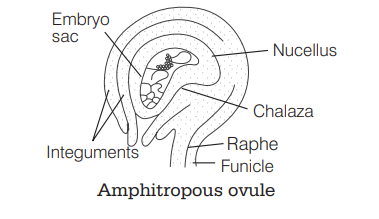
Question
Anthesis is a phenomenon which refers to [CBSE AIPMT 2004]
(a) reception of pollen by stigma
(b) formation of pollen
(c) development of anther
(d) opening of flower bud
Answer/Explanation
Ans. (d)
Anthesis is the opening of floral buds. Reception of pollen by stigma is called pollination. Formation of pollen is called microsporogenesis.
Question
An ovule which becomes curved so that the nucellus and embryo sac lie at right angles to the funicle is [CBSE AIPMT 2004]
(a) hemitropous
(b) campylotropous
(c) anatropous
(d) orthotropous
Answer/Explanation
Ans. (a)
In hemitropous type, the ovule becomes curved and nucellus and embryo sac lie at right angles to the funicle, e.g. Ranunculaceae and Primulaceae.
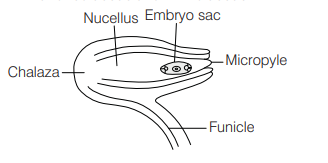
Question
In a flowering plant, archesporium gives rise to [CBSE AIPMT 2003]
(a) only tapetum and sporogenous cells
(b) only the wall of the sporangium
(c) both wall and the sporogenous cells
(d) wall and the tapetum
Answer/Explanation
Ans. (c)
The archesporial cells divide periclinally, cutting off primary parietal layer (forming wall later on) towards the outer side and primary sporogenous cells towards the inner side. The cells of the primary parietal layes divide by successive periclinal and anticlinal division to form concentric layers of pollen sac wall.
Question
Which type of association is found in between entomophilous flower and pollinating agent? [CBSE AIPMT 2002]
(a) Mutualism
(b) Commensalism
(c) Cooperation
(d) Co-evolution
Answer/Explanation
Ans. (a)
A plant and its pollinator have a mutualistic relationship. The plant uses its pollinator to ensure cross-pollination while pollinator uses the plant as food.
Question
In angiosperms all the four microspores of tetrad are covered by a layer which is formed by [CBSE AIPMT 2002]
(a) pectocellulose
(b) callose
(c) cellulose
(d) sporopollenin
Answer/Explanation
Ans. (b)
The deposition of callose starts in pollen mother cell as it enters meiosis and is complete by the end of first meiotic division. By the time tetrad are formed; the common callose wall dissolves, even then all the four microspores lie within a common callose wall.
Question
What is the direction of micropyle in anatropous ovule? [CBSE AIPMT 2002]
(a) Upward
(b) Downward
(c) Right
(d) Left
Answer/Explanation
Ans. (b)
Body of the anaptropus ovule gets inverted and micropyle is on lower side (downward). Further micropyle and funiculus lie side by side and micropyle is close to hilum.
Question
Anemophily type of pollination is found in [CBSE AIPMT 2001]
(a) Salvia
(b) bottle brush
(c) Vallisneria
(d) coconut
Answer/Explanation
Ans. (d)
Pollination through air is known as anemophily e.g. coconut. In Salvia, the pollination is taken place by insects (entomophily). In Vallisneria, the pollination occurs through water (hydrophily). In bottle brush (Callistemon) the pollination occurs through birds (ornithophily).
Question
Eight nucleate embryo sacs are [CBSE AIPMT 2000]
(a) always tetrasporic
(b) always monosporic
(c)always bisporic
(d) sometimes monosporic, sometimes bisporic and sometimes tetrasporic
Answer/Explanation
Ans. (d)
Megaspore is a haploid structure which divides and gives rise to embryo sac which is also called as female gametophyte. Eight-nucleate embryo sacs may be monosporic (e.g. Polygonum) or bisporic (e.g. Allium) or tetrasporic(e.g. Adoxa).
Question
Flowers showing ornithophily show few characteristic like [CBSE AIPMT 1999]
(a) blue flower with nectaries at base of corolla
(b) red sweet scented flower with nectaries
(c) bright red flower into thick inflorescence
(d) white flowers with fragrance
Answer/Explanation
Ans. (b)
Ornithophily is an allogamy performed by birds, such as long beaked small birds (sun birds, humming birds), crow, parrot, bulbul, etc. Ornithophilous flowers are large and showy cup-shaped with abundant nectar or edible part, e.g. Bombax, Agave, etc.
Question
How many pollen grains will be formed after meiotic division in 10 microspore mother cells? [CBSE AIPMT 1996]
(a) 10
(b) 20
(c) 40
(d) 80
Answer/Explanation
Ans. (c)
One microspore mother cell form four pollen grains after meiotic division, so, 10 microspore mother cells will form 40 pollen grains through dividing meiotically.
Question
In an angiosperm, how many microspore mother cells are required to produce 100 pollen grains? [CBSE AIPMT 1995]
(a) 25
(b) 50
(c) 75
(d) 100
Answer/Explanation
Ans. (a)
In angiosperms, each Microspore Mother Cell (MMC) undergoes meiosis to produce four microspores which develop into pollen grains. Thus, to produce 100 pollen grains, 25 micropore mother cells are required.
Question
Chief pollinators of agricultural crops are [CBSE AIPMT 1994]
(a) butterflies
(b) bees
(c) moths
(d) beetles
Answer/Explanation
Ans. (b)
Bees are considered the most common pollinators which pollinate about $80 \%$ of the total insect pollinated flowers.
Question
Ovule is straight with funiculus, embryo sac, chalaza and micropyle lying on one straight line. It is [CBSE AIPMT 1993]
(a) orthotropous
(b) anatropous
(c) campylotropous
(d) amphitropous
Answer/Explanation
Ans. (a)
Orthotropous or atropous is the erect ovule in which the body of ovule lies straight and upright over the funicle. Hilum, chalaza and micropyle occur on one straight line, e.g. family-Polygonaceae and Piperaceae.
Question
Number of meiotic divisions required to produce $200 / 400$ seeds of pea would be [CBSE AIPMT 1993]
(a) $200 / 400$
(b) $400 / 800$
(c) $300 / 600$
(d) $250 / 500$
Answer/Explanation
Ans. (d)
200 seeds of pea would be produced from 200 pollen grains and 200 embryo sacs. 200 pollen grains will be formed by 50 microspore mother cells, while 200 embryo sacs will be formed by 200 megaspore mother cells. Similarly 400 seeds of pea would be produced from 400 pollen grains and 400 embryo sacs. 400 pollen grains will be formed by 100 Microspore Mother Cell (MMC) and 400 embryo sacs fromed by 400 Megaspore Mother Cell(MMC). Thus, number of meiotic divisions required to produce $200 / 400$ seeds would be $250 / 500$.
Question
Meiosis is best observed in dividing [CBSE AIPMT 1992]
(a) cells of apical meristem
(b) cells of lateral meristem
(c) microspores and anther wall
(d) microsporocytes
Answer/Explanation
Ans. (d)
Microsporocytes or microspore mother cells are diploid cells formed from sporogenous cells in the anther. The pollen/microspore mother cells undergo meiosis and form tetrads of microspores or pollen grains. The wall of pollen mother cell degenerates and pollen or microspores separate.
Question
Point out the odd one [CBSE AIPMT 1991]
(a)nucellus
(b)embryo sac
(c) micropyle
(d) pollen grain
Answer/Explanation
Ans. (d)
Nucellus is the parenchymatous nutritive tissue of ovule, micropyle is the pore present in the integuments at one end of ovule and embryo sac represents the female gametophyte. Thus, nucellus, micropyle and embryo sac are part of ovule, whereas, pollen grain/microspore represents the immature male gametophyte.
Question
Pollination occurs in [CBSE AIPMT 1991]
(a) bryophytes and angiosperms
(b) pteridophytes and angiosperms
(c) angiosperms and gymnosperms
(d) angiosperms and fungi
Answer/Explanation
Ans. (c)
Pollination is the transfer of pollen grains from anther to stigma of same or different flower. It is a characteristic features of higher plants, i.e. angiosperm and but also found in few gymnosperms.
Question
Embryo sac occurs in [CBSE AIPMT 1991]
(a) embryo
(b) axis part of embryo
(c) ovule
(d) endosperm
Answer/Explanation
Ans. (c)
Embryo sac occurs in ovule. Megaspore mother cell is developed inside the nucellus of the ovule and by a meiotic division it forms four megaspores, out of which three degenerate. The functional megaspore divides mitotically to form embryo sac.
Question
Female gametophyte of angiosperms is represented by [CBSE AIPMT 1990]
(a) ovule
(b) megaspore mother cell
(c) embryo sac
(d) nucellus
Answer/Explanation
Ans. (c)
In angiosperms, female gametophyte is represented by embryo sac. Embryo sac is produced by the functional megaspore formed through meiosis of megaspore mother cell in ovule.
The common type of embryo sac is monosporic Polygonum type, it is 7-celled and 8-nucleate structure covered by a thin membrane formed of megaspore wall.
Question
Male gametophyte of angiosperms/monocots is [CBSE AIPMT 1990]
(a) microsporangium
(b) nucellus
(c) microspore
(d) stamen
Answer/Explanation
Ans. (c)
Microspore or pollen grain is an immature male gametophyte and thus, represents the first cell of gametophytic generation in angiosperms. Microspores are generally rounded, small, uninucleate haploid cells produced as a result of meiosis in microspore mother cell inside the microsporangia. The process of formation of microspore inside the pollen sacs of anthers is known as microsporogenesis.
Question
Male gametophyte of angiosperms is shed as [CBSE AIPMT 1988]
(a) four-celled pollen grain
(b) three-celled pollen grain
(c) microspore mother cell
(d) anther
Answer/Explanation
Ans. (b)
In angiosperms, pollen grains are generally shed from the anther at 2-celled stage, i.e. one generative cell and one vegetative cell. But, in some angiosperms, the generative cell divides prior to the dehiscence of anther and shed at 3 -celled stage, i.e. one vegetative cell and two male gametes. Double fertilisation was discovered by Nawaschin (1898) in Fritillaria and Lilium. It was confirmed by Guignard (1899).